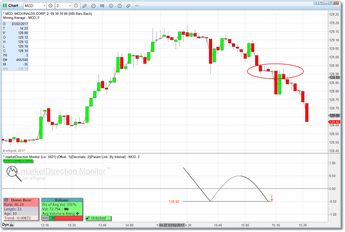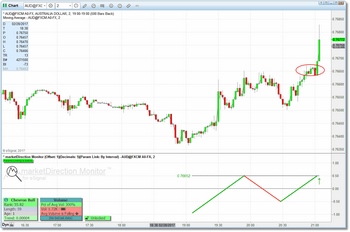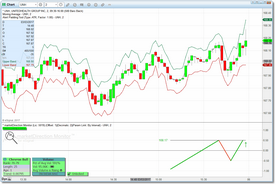
Alert Padding
The default alert condition logic used in marketDirection Monitor is fairly sensitive. For example, with the Dome & Chevron formations the alert condition will be generated whenever price moves past the price level that defines the top or bottom of the formation. In today's markets, often times price will briefly retrace and/or consolidate as the formation completes.
In the examples above an alert condition would have been generated just as the formation completes since price did push past the specified level, but the actual sustained move did not occur until several bars later.
Setting Up Alert Padding
If you prefer to only be alerted if/when a formation results in a move of some significance then you can make use of the two Alert Padding parameters in the Settings menu:
Alert Padding - Type |
Here you specify what will be used as the basis to 'pad' the alert levels. You can select from "Min Tick" and "ATR".
"Min Tick" simply refers to the minimum tick increment for the security. So for a US equity it will probably be 0.01, while for a currency it could be 0.0001 or 0.001. We use the eSignal getMinTick() function at run time to determine a particular security's tick value.
"ATR" would be the Average True Range value as of the last bar of the formation.
Of the two choices, ATR is more universal as it can be applied consistently across a broad range of securities and bar intervals.
|
Alert Padding - Factor |
This is simply the multiplier to be used in conjunction with the Type that you selected above.
So, for example, if you select "Min Tick" as the Type and 5 as the Factor then the alert padding would be set to 5 ticks, and for each security in your watchlist it will be applied to the actual tick value for that particular instrument.
If you select "ATR" as the Type and 0.25 as the Factor then the alert padding would be set to (0.25 * ATR), where ATR is the actual value of the Average True Range calculation for the particular security and bar interval being used as of the last bar of the formation. The length used for the actual Average True Range calculation can be adjusted in the Settings menu.
If Factor is set to 0 (the default value) then Alert Padding is not used.
|
In the marketDirection Monitor formula folder you will find an additional indicator called AlertPaddingTool.efs. You can load this indicator into any chart and it will allow you to experiment with different Alert Padding - Type and Alert Padding - Factor settings so you can determine what works best. It will plot two bands. The Upper band is the high of the bar plus the Factor * Type and the Lower band is the low of the bar minus Factor * Type.
Once configured, the Alert Padding will be added to the original alert condition price level for the formation in question and an alert condition will only be generated if/when price moves past this new price level. Each formation group has its own Alert Padding parameters so you can customize this on a formation-by-formation basis. Note that Alert Padding will affect all alerts (i.e., the visual (♫) alert in the watchlist Status column as well as any audible, pop-up, or email alerts that may be currently active in the chart and/or the watchlist).
The Alert Padding feature is very useful if you don't plan on actively monitoring the watchlist display (i.e., you don't plan on inspecting each and every formation as they occur and would rather wait to be alerted only when price has begun to move away from the formation).
|
Note: The Alert Padding parameters are integrated into the params linking logic, meaning that if you define Alert Padding for any formations in the watchlist then the chart component will automatically apply those same settings. |
See Also:




